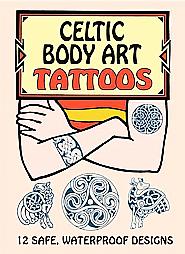Celtic Body Art Biography
You can get different types of celtic tattoos in the celtic art. Celtic body art incledes celtic cross tattoo, celtic knot tatoo as well as celtic ring tattoo and many more.
The ancient Celts of the British Isles were known to dye their hair and paint and tattoo their bodies. The spiraling and interlocking art created by those ...
The Celts were a tribal people who moved across Western Europe sometime around 1200 and 700 B.C. They reached the British Isles around 400 B.C. and most of what has survived from that culture is in the areas now known as Ireland, Wales and Scotland. Celtic culture was full of body art. Men and women both wore long hair and lots of jewelry. Women stained their fingernails, and used berries and herbs for rouge and hair dye. Body painting was done with woad, which left a blue design on the skin.
Elements of art from neolithic tribes that predate the Celts have become blended into what was the actual Celtic art form. So has the knotwork illustrations that arrived with the Saxon Christian monks in Britain in the 6th century A.D. This art style was used by the Saxons, the interlocking animal shapes descended from their Viking roots. All these influences can be seen today in what is called Celtic tattooing. Designs work equally well in black and white or full color.
Spirals are very common in Celtic art, and they can be single, doubled or tripled. This design is thought of an representing spirit or balance. The triskelion, a three-legged pattern, is a common design and has interpretations both as the ancient Triple Goddess and the Holy Trinity.
Zoomorphic figures refer to the interlocking animal designs. The Celts were influenced heavily in their art by nature and you find birds, horses, dogs and more with ears and limbs interweaving. The various animals stood for qualities much like they do in the use of totem animals. La Tene art of the Celts has lots of spirals and leaf-shaped designs intercrossing to sometimes form animal shapes nad celtic symbols overall.
Knotwork is probably the most recognized form of Celtic art, with lines forming complex braids which then weave across themselves. These symbolize the connection of all life. Step or key patterns, like those found in early labyrinth designs, are seen both in simple borders and full complex mazes. Much as labyrinths are walked, these designs are symbolic of the various paths that life’s journey can take.
You can get different types of celtic tattoos in the celtic art. Celtic body art incledes celtic cross tattoo, celtic knot tatoo as well as celtic ring tattoo and many more.
The ancient Celts of the British Isles were known to dye their hair and paint and tattoo their bodies. The spiraling and interlocking art created by those ...
The Celts were a tribal people who moved across Western Europe sometime around 1200 and 700 B.C. They reached the British Isles around 400 B.C. and most of what has survived from that culture is in the areas now known as Ireland, Wales and Scotland. Celtic culture was full of body art. Men and women both wore long hair and lots of jewelry. Women stained their fingernails, and used berries and herbs for rouge and hair dye. Body painting was done with woad, which left a blue design on the skin.
Elements of art from neolithic tribes that predate the Celts have become blended into what was the actual Celtic art form. So has the knotwork illustrations that arrived with the Saxon Christian monks in Britain in the 6th century A.D. This art style was used by the Saxons, the interlocking animal shapes descended from their Viking roots. All these influences can be seen today in what is called Celtic tattooing. Designs work equally well in black and white or full color.
Spirals are very common in Celtic art, and they can be single, doubled or tripled. This design is thought of an representing spirit or balance. The triskelion, a three-legged pattern, is a common design and has interpretations both as the ancient Triple Goddess and the Holy Trinity.
Zoomorphic figures refer to the interlocking animal designs. The Celts were influenced heavily in their art by nature and you find birds, horses, dogs and more with ears and limbs interweaving. The various animals stood for qualities much like they do in the use of totem animals. La Tene art of the Celts has lots of spirals and leaf-shaped designs intercrossing to sometimes form animal shapes nad celtic symbols overall.
Knotwork is probably the most recognized form of Celtic art, with lines forming complex braids which then weave across themselves. These symbolize the connection of all life. Step or key patterns, like those found in early labyrinth designs, are seen both in simple borders and full complex mazes. Much as labyrinths are walked, these designs are symbolic of the various paths that life’s journey can take.
Celtic Body Art
Celtic Body Art
Celtic Body Art
Celtic Body Art
Celtic Body Art
Celtic Body Art
Celtic Body Art
Celtic Body Art
Celtic Body Art
Celtic Body Art
Celtic Body Art
Celtic Body Art












No comments:
Post a Comment